人教版高中英语必修一Unit5教案
人教版高中英语必修一 教案: unit 5 Nelson Mandela--a modern hero Reading
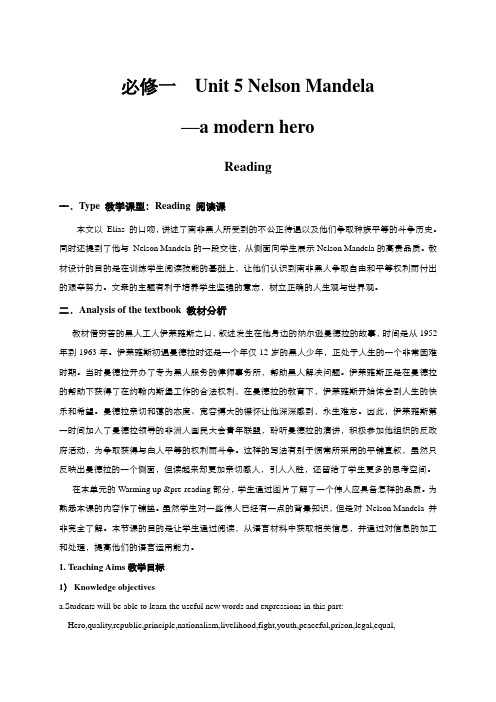
必修一Unit 5 Nelson Mandela—a modern heroReading一.Type 教学课型:Reading 阅读课本文以Elias 的口吻,讲述了南非黑人所受到的不公正待遇以及他们争取种族平等的斗争历史。
同时还提到了他与Nelson Mandela的一段交往,从侧面向学生展示Nelson Mandela的高贵品质。
教材设计的目的是在训练学生阅读技能的基础上,让他们认识到南非黑人争取自由和平等权利而付出的艰辛努力。
文章的主题有利于培养学生坚强的意志,树立正确的人生观与世界观。
二.Analysis of the textbook 教材分析教材借穷苦的黑人工人伊莱雅斯之口,叙述发生在他身边的纳尔逊曼德拉的故事,时间是从1952年到1963年。
伊莱雅斯初遇曼德拉时还是一个年仅12岁的黑人少年,正处于人生的一个非常困难时期。
当时曼德拉开办了专为黑人服务的侓师事务所,帮助黑人解决问题。
伊莱雅斯正是在曼德拉的帮助下获得了在约翰内斯堡工作的合法权利,在曼德拉的教育下,伊莱雅斯开始体会到人生的快乐和希望。
曼德拉亲切和蔼的态度、宽容博大的襟怀让他深深感到,永生难忘。
因此,伊莱雅斯第一时间加入了曼德拉领导的非洲人国民大会青年联盟,聆听曼德拉的演讲,积极参加他组织的反政府活动,为争取获得与白人平等的权利而斗争。
这样的写法有别于惯常所采用的平铺直叙,虽然只反映出曼德拉的一个侧面,但读起来却更加亲切感人,引人入胜,还留给了学生更多的思考空间。
在本单元的Warming up &pre-reading部分,学生通过图片了解了一个伟人应具备怎样的品质。
为熟悉本课的内容作了铺垫。
虽然学生对一些伟人已经有一点的背景知识,但是对Nelson Mandela 并非完全了解。
本节课的目的是让学生通过阅读,从语言材料中获取相关信息,并通过对信息的加工和处理,提高他们的语言运用能力。
1. Teaching Aims教学目标1)Knowledge objectivesa.Students will be able to learn the useful new words and expressions in this part:Hero,quality,republic,principle,nationalism,livelihood,fight,youth,peaceful,prison,legal,equal,law,advise,continue,gold,passbook,ANC,league,stage,vote,position,accept,violence,devote,vote, guidance, blow up, in troubleb. Enable the students to read Elias’ storyc. Guide the students to know the qualities of Nelson Mandela as a great leader2) Ability objectivesa.Develop the students ’reading skills, such as fast reading ,careful reading and summarizingb.Improve the students’ comprehension ability3) Emotion objectivesa,Understand the qualities great person have in common and learn the fine qualities from themb.Develop the students’ moral quality2.Teaching important points教学重点a.Enable the students to read Elias’ story and Learn to grasp the main idea of the text.b.Enable students to talk about the fine qualities of great people,especially Nelson Mandelac.Improve the students’ reading ability3.Teaching difficult points 教学难点a.How to grasp the main idea of the text.b.How to help develop students’ reading abilityc.How to help students learn from Nelson Mandela4.Teaching methods 教学方法a.Student-centeredb.Task-based teaching method(任务型教学)c.Discussion5.Learning methods 学习方法Individual or pair work and group work6.Teaching Aids 教具准备The multimedia三.教学设计1. 总体思路本堂课的主要内容分为四大部分,Pre-reading(阅读前活动) ,while –reading(阅读中活动),post-reading(阅读后活动)以及discussion(讨论) and role play 。
人教版高中英语必修一 教案: unit 5 Nelson Mandela--a modern hero Language points4
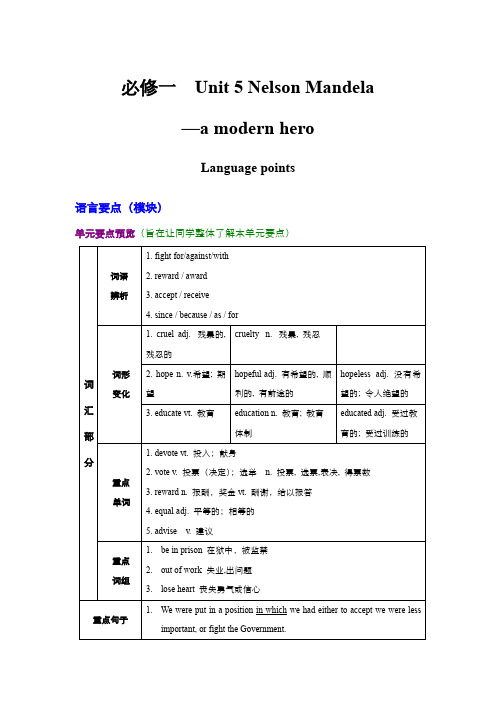
必修一Unit 5 Nelson Mandela—a modern heroLanguage points语言要点(模块)单元要点预览(旨在让同学整体了解本单元要点)Ⅰ词语辨析(旨在提供完形填空所需材料)与后面的分句对前一句话起到补充说明的作用II词性变化(旨在提供语法填空所需材料)Parents should _________ their children to behave well. (educate)s tudentsⅢ重点词汇(旨在提供综合运用所需材料)1. devote vt.投入;献身[典例]1). He devoted himself entirely to music. 他将一生奉献给了音乐。
2). Mary devoted her life to caring for the sick. 玛丽献身于为病人服务。
[重点用法]devote… to… 献身于;专心于在devote… to…短语中,to是介词,后面接名词或动词-ing。
常见的类似短语还有:pay attention to(注意……); stick to(坚持……); lead to(导致……); prefer…to(相比……更喜欢……); look forward to(盼望……);[练习] 中译英1). 她深爱她的孩子。
2). 我们应全力以赴地工作。
Keys: 1). She is devoted to her children.2). We should devote all our efforts to our tasks.2. vote v. 投票(决定);选举n. 投票, 选票,表决, 得票数[典例]1). We voted Democrat in the last election. 我们在上次的选举中投了民主党的票。
2). We’ll listen to the arguments on both sides and then vote on it.我们会先听取双方的论证后再作表决。
新人教版必修一Unit 5 Languages Around the World Grmmar教案

必修一Unit 5 Languages Around the World Grammar教案Learning aims:语言能力:主题:世界上的语言词汇:billion, native, attitude, reference, refer, system, despite, factor…语法:理解并运用关系副词when, where, why引导的定语从句;理解in/on/at which在定语从句中相当于when, where。
学习能力:运用寻读技巧快速找到阅读文本的相关信息;结合上下文理解词义。
文化意识:了解汉字的发展史,思考未来汉字的发展与使用;了解联合国的六种工作语言,从多角度思考外语学习的动机,积极探寻和思考语言学习的各种技巧和方法。
思维品质:通过观察语言和文化的发展,客观分析,辩证思考事物发展的因果关系;从多个视角认识世界,归纳与建构影响中国发展的多元因素。
Procedures:Step 1: lead-inOne language sets you in a corridor for life.Two languages open every door along the way.—— Frank Smith Step 2 Discovering Useful Structures of the Attributive Clauses定语从句Attributive Clause /Relative Clause1,定义:一个句子跟在一个名词或代词后进行修饰限定叫做定语从句。
按语法句式,定语从句在整个句子中做定语的成分。
被定语从句修饰的名词或代词叫先行词。
2,关系词分为:关系代词:who,whom,whose,which,that,as关系副词:when,where,why3,关系词的三大作用:连接作用;替代作用;成分作用。
It is the day when we went to school. 代替the day, 做时间状语。
最新人教版高中英语必修一unit5《nelsonmandela》全单元教案.doc
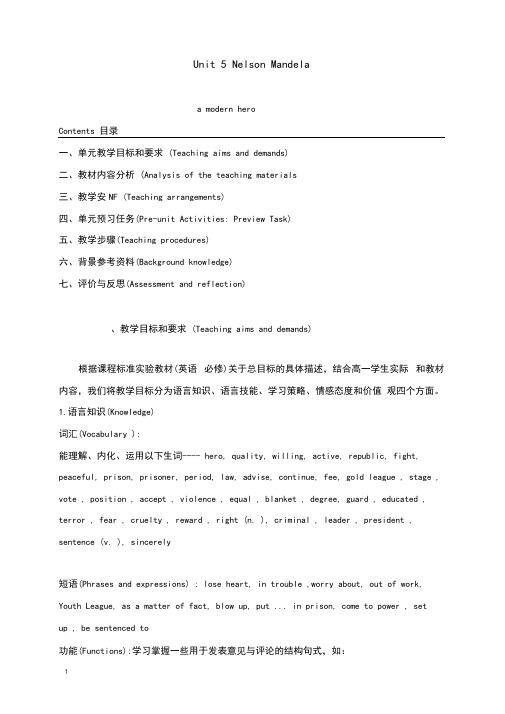
Unit 5 Nelson Mandelaa modern heroContents 目录一、单元教学目标和要求(Teaching aims and demands)二、教材内容分析 (Analysis of the teaching materials三、教学安NF (Teaching arrangements)四、单元预习任务(Pre-unit Activities: Preview Task)五、教学步骤(Teaching procedures)六、背景参考资料(Background knowledge)七、评价与反思(Assessment and reflection)、教学目标和要求(Teaching aims and demands)根据课程标准实验教材(英语必修)关于总目标的具体描述,结合高一学生实际和教材内容,我们将教学目标分为语言知识、语言技能、学习策略、情感态度和价值观四个方面。
1.语言知识(Knowledge)词汇(Vocabulary ):能理解、内化、运用以下生词---- hero, quality, willing, active, republic, fight, peaceful, prison, prisoner, period, law, advise, continue, fee, gold league , stage , vote , position , accept , violence , equal , blanket , degree, guard , educated , terror , fear , cruelty , reward , right (n. ), criminal , leader , president , sentence (v. ), sincerely短语(Phrases and expressions) : lose heart, in trouble ,worry about, out of work, Youth League, as a matter of fact, blow up, put ... in prison, come to power , setup , be sentenced to功能(Functions):学习掌握一些用于发表意见与评论的结构句式,如:1. 发表意见(Giving opinions )Why do you think so? What do you think of …? What's you opinion?agree / don't agree. I think / don't think .... I prefer .... In myopinion ....I'm afraid ....2.评论(Making comments)Good idea! That's an excellent idea .语法(Grammar):定语从句(II )(由where, when, why, 介词+ which, 介词+ whom引导的定语从句)The school where I studied only two years was three kilometres awayThis was a time when you had got to have a passbook to live in JohannesburgThe reason why I got a job was because of my hard work .•••we were put in a position in which we had either to accept we were less important, or fight the Government .The person to whomyou should be grateful for a peaceful South Africa is Nelson Mandela.扩展词汇:negative(消极的),heroine(女主角,女主人公),unwilling(不情愿的),nation(国家,民族),sacrifice(牺牲),realize (认识到),give up (放弃),riches (财富),Bible (圣经),revolution (革命),career (职业),equality (平等),fairness(公平),conflict (冲突),biography (自传),beliefs (信仰),Christianity (基督教),religion (宗教),priests (牧师),version (翻译),readable (易读的),adventure (冒险),scholar (学者),sympathy (同情),,campaign (从事活动),communist (共产主义者),injustice (不公平),oppose (反对),pilot(飞行员) , boycott (联合抵制)2.语言技能(Skills)听:在本单元的课文及练习册听力教学中,能听懂人物和事件以及它们的关系,能抓住所听语段中的关键词,正确理解话语间的逻辑关系。
英语人教版高中必修一 教案Unit 5 Discovering Useful Structures

Unit 5 Languages Around the WorldPeriod 3 Discovering Useful Structures教材分析本节课为语法课,主题为“描述你喜欢的事物”(Describe your favorite things)。
教学内容为限制性定语从句和关系副词when,where,why,介词+which的用法。
首先,通过观察上一课时“Reading and Thinking”课文中出现的句子,要求学生归纳限制性定语从句中关系副词的用法。
接着,通过完成单句填空、语篇填空等练习帮助学生更加熟练地掌握限制性定语从句中关系副词的用法。
最后,通过真实语境,进行语言输出。
利用定语从句准确表达自己的喜好,描述最喜欢的人、物、时间、地点、原因等。
教学目标在本课学习结束时,学生能够:1. 观察和归纳限制性定语从句中关系副词when,where,why,介词+which的用法。
2. 运用定语从句的语法知识,理解语境、语篇意义。
3. 运用定语从句表达看法和描述喜好。
教学重难点【教学重点】1. 掌握限制性定语从句中关系词的用法。
2. 理解含有限制性定语从句的语篇。
【教学难点】运用定语从句,准确描述喜好。
教学过程Step 1 Warming-up1. When does written Chinese language date back to?2. What is longgu?Step 2 ObservingRead the sentences from the passage and underline the restrictive clauses.设计意图:学生观察句子,复习限制性定语从句,找到由关系副词引导的限制性定语从句。
Step 3 Grammar SummaryRead the grammar notes on P110 and P111.设计意图:讲解课后P110-P111的语法要点,学习关系副词引导的限制性定语从句。
【教案】Unit+5Discovering+useful+structures教学设计人教必修第一册
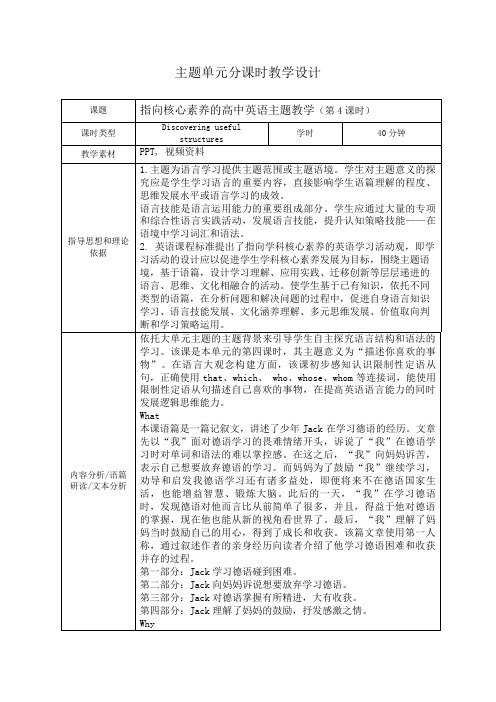
主题单元分课时教学设计课题指向核心素养的高中英语主题教学(第4课时)课时类型Discovering usefulstructures学时40分钟教学素材PPT, 视频资料指导思想和理论依据1.主题为语言学习提供主题范围或主题语境。
学生对主题意义的探究应是学生学习语言的重要内容,直接影响学生语篇理解的程度、思维发展水平或语言学习的成效。
语言技能是语言运用能力的重要组成部分。
学生应通过大量的专项和综合性语言实践活动,发展语言技能,提升认知策略技能——在语境中学习词汇和语法。
2. 英语课程标准提出了指向学科核心素养的英语学习活动观,即学习活动的设计应以促进学生学科核心素养发展为目标,围绕主题语境,基于语篇,设计学习理解、应用实践、迁移创新等层层递进的语言、思维、文化相融合的活动。
使学生基于已有知识,依托不同类型的语篇,在分析问题和解决问题的过程中,促进自身语言知识学习、语言技能发展、文化涵养理解、多元思维发展、价值取向判断和学习策略运用。
内容分析/语篇研读/文本分析依托大单元主题的主题背景来引导学生自主探究语言结构和语法的学习。
该课是本单元的第四课时,其主题意义为“描述你喜欢的事物”。
在语言大观念构建方面,该课初步感知认识限制性定语从句,正确使用that、which、 who、whose、whom等连接词,能使用限制性定语从句描述自己喜欢的事物,在提高英语语言能力的同时发展逻辑思维能力。
What本课语篇是一篇记叙文,讲述了少年Jack在学习德语的经历。
文章先以“我”面对德语学习的畏难情绪开头,诉说了“我”在德语学习时对单词和语法的难以掌控感。
在这之后,“我”向妈妈诉苦,表示自己想要放弃德语的学习。
而妈妈为了鼓励“我”继续学习,劝导和启发我德语学习还有诸多益处,即便将来不在德语国家生活,也能增益智慧、锻炼大脑。
此后的一天,“我”在学习德语时,发现德语对他而言比从前简单了很多,并且,得益于他对德语的掌握,现在他也能从新的视角看世界了。
高一英语必修一UNIT5教案

篇一:高一英语必修一unit5教学设计教材分析我教的是高一年级上册,人教版,必修1, unit5, nelson mandela---a modern hero 的第一课,这是一节高中阅读课。
教材上这一部分主要分为四个部分:由于第一、二部分联系比较紧密,活动设置也比较好,但我觉得这两部分的活动顺序可以调整一下,即把第二部分放在前面,先呈现图片和简介以引起学生注意力和兴趣,以图片展示的形式激励学生用英语进行语言实践活动,然后归纳出hero的一个模糊标准,为阅读活动做好铺垫。
然后再让他们自己说出他们所认为的a great person 所拥有的品质,这样可能更符合学生的思维习惯特点,并且有利于调动他们的积极性和培养他们说语言的能力。
因此,我决定吧第一、二部分结合在一起作为pre-reading 部分来讲,但顺序做一下调整,之后是正式人物曼德拉的登场,进入主题alias眼中的曼德拉,重点把nelson mandela 挑出来,附加更多关于他的信息,稍加重点地呈现,因为他的信息与接下来的reading passage 联系非常紧密,我想通过重点呈现关于他的信息来提高给学生更多background information,帮助他们更好地理解reading text.第三部分是一个关于elias’ story 的reading text,属于人物传记式的阅读,但是文章的写作角度比较特别,由穷苦的黑人工人alias叙述他眼中的曼德拉,这样的写法比较客观可信。
alias的故事与遭遇同时也成为本文与本课的一条贯穿总线,也是这堂课的中心阅读任务。
学生要做的主要活动就是阅读并理解文章的内容和大意,同时注意一些重点细节信息的把握。
另外,在时间允许的情况下,我还想做一些扩展性的教学活动,比如让学生复述alias 的经历,即达到检测学生的理解又能挑战学生说英语的能力。
the background of students:(1) the supporting background information should be given to students before reading to get them ready and not feel difficult.(2) the teaching procedures and reading task should be designed adaptive to students’ current ability and their cognitive style.(3) teacher should give students necessary guidance on reading strategies(4) teacher should be amiable and patient to make students less nervous.correctly to encourage them and improve their confidence.teaching plan for s1 a reading lesson (lesson 1, unit 5, 必修1)nelson mandela---a modern heroname: 颜巧云 class: english 07(4) group: 4-1teaching/learning objectives4. develop reading skills: skimming, scanning and generalizing the central meaning of the textteaching procedures:stage1. pre-reading (5-10 minutes)do you think he is a great man?step2. guess game for prediction (present pictures of 6 famous persons both in nelson mandela.step2. check ss’ understanding of the main idea of each paragraph through matching.step2. guide ss to finish t/f exercises and give their reasons to check ss’understanding of specific information.information and train their independent thinking and judgment, and help to enhance their ability to organize their ideas logically.people equal?e.g. 1940: born1946: six, educated, 2 years1948: leave school, could not pay fee……….stage3. post-reading (10-15 minutes)step2. listen to the tape and read the quotes from nelson mandela to help ss feel the passion and the firm faith of the great man.step3. guide ss to summarize and explore the implied meaning of the text---a great man need not to be famous, he / she must have some good qualities and devote themselves to helping others.(1) ss try to summarize the language points by themselvespart of verbatim plan for lesson1, unit5, s1a, 必修1-----nelson mandela- a modern herot: (after greeting ss)ss: (some ss may give their opinions)t: do you think he is a great man?ss: yes/no.ss: yes/ no.ss: (get into brainstorming)…t: ok, class, have you finished it?ss: yes.篇二:人教版高中英语必修一 unit 5教案unit 5 nelson mandela——a modern hero教材分析:本单元以 nelson mandela —— a modern hero 为话题,目的在于使学生了解一个伟大的人应具备怎样的品质,学会表达自己的观点,并用所学的句型来描写一个伟人。
人教版高中英语必修一Unit5教案

Unit 5 NelsonMandela——a modernhero教材分析:本单元以NelsonMandela—— a modernhero为话题,目的在于使学生了解一个伟大的人应具备怎样的品质,学会表达自己的观点,并用所学的句型来描写一个伟人。
Teachin g aims:1. To arouseSs’interes t in learnin g about heroesin history2. To developSs’listeni ng and speakin g ability.Teachin g procedu res:Step1 warming up●Describ e yoursel vesFirst what kind of personare you? (shy, outgoin g, fun, mean, immatur e, nice, kind, honest,brave, loyal, happy, wise, smart, friendl y, warm, cheerfu l, popular, generou s, hard-working, diligen t, weak, stupid, lazy, dishone st, tense, cold, unkind, miserab le, dull, strong-minded, determi ned etc.)●Discuss ion (Encoura ge student s to give five or six qualiti es that they think greatpersons have, and give their reasons.)● Questio n 1: Who do you think are the greates t men in your mind? Can you namesome?Questio n 2: In what way do you conside r a man is a great? What is your standar d?●Look at page 33 and then ask the Ss if these famouspeopleare great people.●Conclus ion:A great personis a personwho has followe d his or her ideas and sacrifi ced(牺牲) somethi ng so that they could be realize d. A pop singermay be very popular with the young people, but he/she is not a great man/woman.A famouspersonmay be well-known but if he or she has not gone through struggl es and difficu ltiesfor their noble aims, they can not be calleda great person.Step2 languag e points:1.devotevtoneself to 献身于、致力于。
2019新人教高中英语必修一Unit5languages around the world整单元教案

2019新人教高中英语必修一Unit 5 Languages around the world整单元公开课教案2019新人教高中英语必修一Unit5 Listening and speaking教案Teaching aims:1.Enable students to get familiar with languages,especially the 6 official languages of the UN.2.Better understand the pronouns and what the pronouns refer to in listening.3.Talk about the languages and tell the reasons in simple English.Teaching key points:1.Help students get familiar with the vocabulary of different countries and their languages through listening practice.2.Try to arouse the students’ interest in language learning in thematic context. Teaching difficult points:1.Enable students to be aware of pronouns in daily conversation and be able to understand the content of pronoun reference correctly in the process of Listening.2.Enable students to fully discuss the reasons and motivation of language learning. Teaching procedures:Step1 Lead-inLook at the opening page and discuss the following questions with your students. T:Which languages do you think are officially used in the UN?Ss:English, French, Russian, Chinese, Spanish...T:How do you understand the quote:One language sets you in a corridor for life.Two languages open every door along the way?Ss:Mastering more languages can give you many chances in your life including your work opportunities, your horizon, your fully understanding of the world.Step2 Listening:Explore languages around the world Activity1 Warming upBefore you listen, match each photo with the correct country name. Then discuss which languages are spoken in these countries.(Ex1on page 60)123456France 3 French Russia 4 Russian Germany 2 German Spain 6 Spanish Canada 1 English, French India 5 Hindi, English Activity2: First listeningFor the first listening, you are required to tick the two languages with the most native speakers.Circle the official languages of the United Nations. And then answer the four questions below.1.What is the main topic of this speech? Learning a foreign language.2.How many languages are there in the world? Nearly 7000.3.How many people speak the UN’s official languages as their native or second language? Around 2.8 billion.4.What is the attitude of the speaker towards foreign language learning?It’s very useful to learn one or more foreign languages.Activity3 Second listeningT: Boys and girls, for the second listening, please pay special attention to the pronouns in the speech, especially focus on the italicized words in the sentences below and what they refer to.1.They think it means better job chances in the future.They:students who choose to study a UN language. it: studying a UN language2.They are spoken by around 2.8 billion people.They: the six official UN languages.Activity4 Third listeningListen to the speech for the last time and fill in the blanks with words and phrases you hear(通过最后一遍听力的练习,让学生掌握和熟悉表达态度以及原因的句式,从而为说的练习做好充足的语言支架)To some students,it seems that the only foreign language to learn is English.There are,however,nearly 7,000 languages in the world.After Chinese,the language with the most native language speakers isn’t English—it’s Spanish.Learning English is very useful,but, it is wise to learn at least one other foreign language if possible.There are many reasons why people learn a foreign language.Many students choose to study one of the languages that are spoken at the UN.As they think it means better job chances in the future.The UN has six official languages:Arabic,Chinese,French,Russian,and Spanish.They are spoken by around 2.8 billion people as their native or second language.Some students,though,choose to study a language because of family or friends.One American girl chose to learn Danish because her grandparents were from Denmark.When she was little,her grandpa used to read letters to her in Danish from their relatives in Denmark.Another young lady started learning French because she had several friends from African countries where French is spoken.Step3 Speaking1.Review the listening material and try to complete the table below.(红色部分为学生填写)2.Work in pairs or groups.Discuss which other languages you want to learn and why.(Ex5 on Page61)Example:A:What language do you want to study?B: I really want to study French. I think that the French language sounds beautiful. A:Why? Do you want to go to France some day?B: Yes, I’d love to. Also, French is used by many international organizations around the world. Do you know that FIFA’s full name is in French?A:oh, I remember that. But I don’t know how to pronounce it.Step 4 Homework1.Review the new words learnt from the listening material.2.Tell your partner what language you would love to learn in the future and why.2019新人教高中英语必修一Unit 5 Reading and Thinking教案Teaching objectives:1.Enable students to get familiar with the development history of the Chinese writing system.2.Apply prediction and scanning strategies for main idea in reading.3.Identify the main structure of the passage and talk about a topic through the timeline.e some important words and phrases to describe the development of Chinese writing system.Teaching key points:1.Figure out the main structure of the passage and know the development of the Chinese writing system and increase their cultural confidence.2.Understand the narrative characteristics of “time-event”in the illustrative style and judge the writing purpose and intended readers of the passage.Teaching difficult points:1.Apply different approaches of discourage analysis to deepen the understanding of the text and language usages.2.Guide students to explore the function and importance of Chinese character writing system.3.Explore and understand the relationship between Chinese characters and the Chinese civilization.Teaching procedures:Step I Lead-inPlay the song Chinese Character by Chinese famous singer Yuan Yuan,ask them to sing together and share what they know about Chinese characters.Step Ⅱ PredictingAsk the students to look at the title and the picture on Page 62 and predict what the passage will be about.Suggested answer:The title is“The Chinese Writing System”, which is the topic,and connecting the past and the present is the focus, so the passage is about the development of Chinese writing system.Step Ⅱ Skimming for main ideasRead the passage quickly and find the topic sentence for each paragraph.The main idea of each paragraphSuggested answers:Paragraph 1:The Chinese writing system is one of the main factors why Chinese civilization has survived into modern times.Paragraph 2: Written Chinese was a picture-based language at the beginning.Paragraph 3: The writing system became well-developed and later developed into different forms.Paragraph 4: The writing system began to develop in one direction.Paragraph 5:Written Chinese connects China's present with its past,and has become an art form.Paragraph 6:The Chinese language is helping to spread China’s culture and history to the world.Step IV Scanning for detailsAsk the students to find the words and phrases that describe a time and what happened to the characters at each of those important times.Activity 1 Read the passage and find out the words showing the timeline,and then finish the timeline.Question: What kind of words can show the development of the Chinese writingsystem?Draw a timeline to show the narrative order.Suggested answer:modern times(Para.1)→at the beginning(Para.2)→dates back several thousand years(Para.2)→by the Shang Dynasty(around 1600—1046 BCE)(Para. 3)→over the years(Para.3)→the Qin Dynasty(221--207 BCE)(Para. 3,4)→even today (Para.4)→in modern times(Para.5)→today(Para.6)Activity 2 What happened to the Chinese characters at each of those important times?Fill in the table.Suggested answers:1.The Chinese civilization still continues.2.Written Chinese was a picture-based language.3.Longgu appeared.4.Symbols carved on longgu had become a well-developed writing system.5.The writing system developed into different forms, as the Chinese people were divided geographically, leading to many varieties of dialects and characters.6.The Chinese writing system began to develop in one unified direction.7.Chinese people can all still communicate in writing.8.Chinese people can read the classic works which were written by Chinese in ancient times.9.The Chinese writing system is still an important part of Chinese culture.StepⅡReading for languages featuresRead the passage again and find the sentences where the restrictive relative clauses are used.Suggested answers:1. There are many reasons why this has been possible...(Restrictive attributive clause)2.....animal bones and shells on which symbols were carved by ancient Chinese people.(Restrictive attributive clause)3.... it was a time when people were divided geographically.(Restrictive attributive clause)4.Emperor Qinshihuang united the seven major states into one unified country where the Chinese writing system began to develop in one direction.(Restrictive attributive clause)Step Ⅱ DiscussionEncourage students to work in groups,think independently first and then discuss with their partners.1. How did written Chinese unify Chinese people divided by geography and dialects?2.How does written Chinese connect Chinese people today with those of the past?3. According to the writer,the Chinese writing system is one factor that has helped the Chinese language and culture survive. What do you think are some of the other factors ?Suggested answers:1.It allowed Chinese people,no matter where Chinese people live or what dialect they speak to communicate with each other.2.People in modern times can read the classic works in ancient times.3.Except for the writing system of Chinese language, the continuous development of China's agriculture, a relatively powerful government,distinguished philosophical schools,and an open mind to embrace different cultures are all possible and important factors. Besides, education is always emphasized in China's family traditions.Step Ⅲ Vocabulary about the development of Chinese writing system.Activity 1Read the words below and learn them by heart.Activity 2 Use the words and phrases above to introduce the development of the Chinese writing system according to “time & event”.Suggested answer:Several thousand years ago,Chinese characters began as picture-based symbols carved on longgu. By the Shang Dynasty,the symbols had become a well-developed system. Over the years,the system developed into different forms. This, however, changed in the Qin Dynasty when the Chinese writing system began to develop in one direction because Emperor Qinshihuang united seven major states. Even today,not only can Chinese people communicate well by means of it but also many foreign friends come to China to appreciate China's culture and history through this amazing language.Step Ⅲ Homework1.Introduce the development of the Chinese writing system according to “time & event”.2.Try to describe your growth through a timeline.2019新人教高中英语必修一Unit 5 Discovering Useful Structures教案Teaching aims:1.Enable students to have a good understanding of the basic usages of relative adverbs such as when,where,why in attributive clauses;understand the structure in/on/at which in attributive clauses is equivalent to where/when.2.Master the basic usages of relative adverbs of attributive clauses in the real situation through self-study and practice.3.Describe favourite things using the proper relative adverbs of attributive clauses.Teaching key points:1.Help students to appreciate the function of relative adverbs of attributive clauses in a sentence.2.Enable students to master the usage of relative adverbs of attributive clauses flexibly.Teaching difficult points:Use attributive clauses to describe things.Teaching procedures:Step I Lead-inLook at these sentences and underline the restrictive relative clauses.Q:What kind of information does each clause communicate.1.It was a time when people were divided geographically.Information:a time for an event.小结 1 先行词(即被修饰的名词)在从句中作时间状语时,连接词使用when。
2019新人教高中英语必修一Unit5 Listening and Talking公开课教案

2019新人教高中英语必修一Unit5 Listening and Talking 教案Teaching aims:1.Enable students to explore different kinds of English and understand the diversity of English.2.Figure out the main facts and summarize the main ideas when listening.3.Master effective communication strategies and methods of communicating in English.Teaching key points:1.Enable students to master the ways of asking for clarification.2.Develop students' different listening skills to solve different listening comprehensive problems.Teaching difficult points:1.Enable students to be aware of the major differences between British English and American English.2.Enable students to master effective communication strategies and methods of communicating in English.Teaching procedures:Step I Lead-inAsk students to read the words to each other and see if they pronounce them differently. Then,listen and pay attention to how the speakers pronounce them. Work in pairs.Step ⅡListening:Explore different kinds of EnglishActivity 1 The teacher plays the first part of the talk for students and asks students to listen and complete Activity 1.Q:What are the different kinds of English mentioned?Suggested answer: British English, American English, and Australian English.Activity 2 The teacher plays the second part of the talk for students and asks students to listen and completeActivity 2. Tick them in the boxes.Q: What are the two pairs of words that the students are confused by ?restroom/toilet √ subway/underground√semester/term gas/petrolStep ⅢTalking:Explore different kinds of EnglishActivity 1 Ask students to look at the pairs of words.Q: Which words are British English and which are American English?Activity 2 Ask students to think of more pairs of words like these.Q:Can you think of more examples of different words used in British English and American English?Activity 3 Ask students to think about other differences.Q:Do you know any other differences between British and American English besides pronunciation and usages of different words?Step IV Asking for clarificationActivity 1 Ask students to read the conversation and answer the following questions.Questions: What does Zhou Wei want to buy?Why does Martin feel puzzled about what Zhou Wei wants to buy?What misunderstanding has happened ?How do they clear up the misunderstanding?Suggested answer:Zhou Wei wants to buy some pants. In American English,“pants”refers to trousers. But the word “pants”means underwear in British English. Martin explains that“pants”refers to underwear in British English.Activity 2 Ask students to role-play the conversation and find out the expressions to ask for clarification.Confusion:You don't ?Really ?What does it mean?Clarification: That's what I mean by...I knew what you mean.Other expressions:Do you mean...?I'm sorry. Would you mind repeating....?I beg your pardon. So am I right in saying..?So what you're really saying is...Activity 3 Ask students to choose one or two pairs of words and make a conversation asking for clarification with the expressions above.Step V SummaryIn this lesson, we listened to and talked about differences between British English and American English and learned how to ask for clarification when we do not under-stand other people.Although there are some clear differences in pronunciation between British English and American English accents,they do not lead to communication difficulties. As learners, we don't have to worry about copying British or American English accents. A focus on correct intonation and stress is more important.。
人教版高中英语必修一教案Unit 5 Nelson Mandela (含答案)
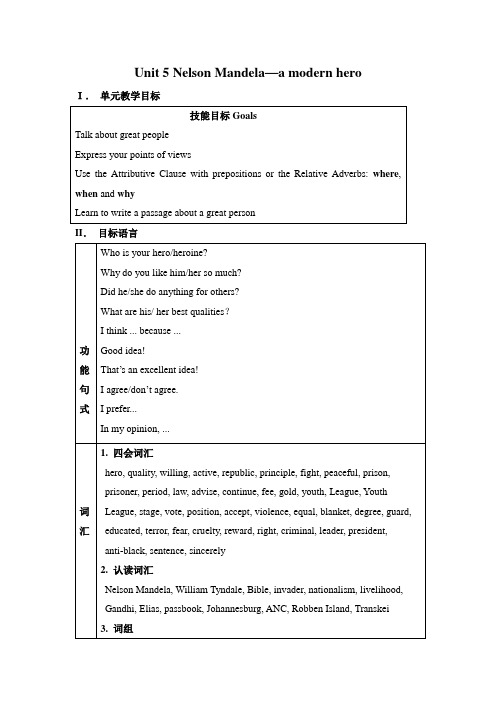
Unit 5 Nelson Mandela—a modern hero I.单元教学目标II.目标语言III. 教材分析和教材重组I. 教材分析本单元以Nelson Mandela —— a modern hero 为话题,目的在于使学生了解一个伟大的人应具备怎样的品质,学会表达自己的观点,并用所学的句型来描写一个伟人。
1.1 Warming Up列出一些形容词让学生判断一下哪些可以用来描述伟大的人,一个伟大的人应具备怎样的品质。
1.2 Pre-reading给学生提供了六个名人的图片,要求利用图片下面标注的人物的重要事迹以及学生对他们的了解,来判断这六个人谁是伟人,谁是重要的人但不是伟人。
1.3 Reading介绍Elias的生平,向学生展示Nelson Mandela是一个怎样的人。
这是一篇记叙文,让学生学会利用时间顺序描述一个人一生的主要活动。
1.4 Comprehending练习1和3帮助学生利用判断正误和时间顺序来整体理解课文。
练习2和4要求学生进一步了解课文细节。
1.5 Learning about Language分词汇和语法两部分。
其中Discovery useful words and expressions是根据课文语境在运用中掌握词汇,Grammar是有关关系副词where, when, why以及“介词+关系代词”引导定语从句的用法,并通过练习加以巩固。
1.6 Using Language分为三部分,一是Listening,练习听力可配合P72的Listening Task进行。
二是Reading,这也是一篇精读文章,更详细地了解曼德拉。
三是Writing,要求利用时间顺序简要地描述一个人。
2. 教材重组2.1 因本教材重点强调的是阅读能力,故将Reading, Comprehending,Using Language 中的Reading合在一起设计成一节“阅读课”(一)(精读课)。
高一英语必修一unit5教案

高一英语必修一unit5教案高一英语必修一unit5教案1(一) 教材地位和教学内容分析本课是高一必修模块1第4单元的阅读课型,这单元围绕earthquakes这一主题开展听、说、读、写多种教学活动。
Reading设计为本单元的第2课时。
本课型是单元整体教学的重要环节,为学生的语言学习、语法学习提供了载体,并且是学生获取信息的主要来源。
“Reading―――A NIGHT THE EARTH DIDN’T SLEEP”具体描写1976年唐山大地震的震前、震中和震后。
本篇文章词汇量大,运用了大量的动词、复杂的数字,出现许多定语从句,篇幅较长,并且采用一些修辞手法,对学生的语言阅读能力提出了更高的要求。
但文章的结构较明显,较容易归纳出各部分的中心词。
(二)教学目标1. 语言知识目标:a)使学生了解自然灾害的相关词汇,并掌握复杂数字的表达法。
b)学习掌握与地震相关的词汇,如:shake,well,rise,smelly,pond,pipe,burst,canal,steam,ruin,injure,destro y,brick,dam,useless,steel,shock,quake,rescue,electricity,disaster,arm y,organize,bury,coal,mine,shelter,fresh,percent等,以及right away, at an end, dig out, give out, thousands of以及一些优美句子的赏析。
2. 语言技能目标:a)阅读技能的训练:让学生学会克服生词障碍,通过略读,归纳出文章的大意;通过细读,理清文章的总体框架与脉络,归纳出各部分的中心词;通过查读,捕捉文章的重要细节,培养学生获取、处理信息的能力。
b) 让学生复述课文,分析、感悟作者的写作意图。
c) 让学生运用本节课所学词汇、知识,通过采访唐山大地震幸存者的形式进行小组活动,提高学生用英语进行创造性交流的能力。
高一英语必修一第五单元教案

高一英语必修一第五单元教案高一英语必修一第五单元教案「篇一」一、教学目标知识目标1. Get students to learn some useful new words and expressions in this part。
2. Get students to read the play。
3. Let students learn the expressions of ordering food。
能力目标1. Develop students’ reading skills and enable them to learn how to use different reading strategies to read different reading materials。
2. Enable students to understand and act out the play。
3. Have students learn how to use the expressions to order food。
情感目标1. Stimulate students’ interests of learning English by reading and acting this play。
2. Develop students’ sense of group cooperation and teamwork。
二、教学重点1. Develop students’ reading and speaking skills。
2. Let students read and act the play。
3. Have students learn to use the expressions to order food。
三、教学难点1. Enable students to learn to use reading strategies such as skimming, scanning, and so on。
新人教必修一Unit 5 Languages Around the World教案

Unit 5 Languages Around the World-Listening andSpeaking【教材分析】不同于旧教材,语言差异在必修一的第二单元,新教材设置在必修一最后一个单元,可以让学生在语言上有所储备,就是在前几个单元的学习中,既有语言知识,也有语音知识,到了这个时候学生就能够有话可说,有感可发,能够找到不同国家英语的区别。
让学生学习不同国家和地区的英语,就可以培养学生的国际视野,可以降低学习英语的恐惧感,也可以让学生明确自己的目标。
【教学目标与核心素养】1.语言能力目标新课标重视培养学生语言的使用能力,本单元通过听来带动说,和平时生活紧密相关,让学生可以体会到不同国家使用英语的过程中会有不同的口音,中式英语也肯定具有它的特点,但是作为语言学习者,我们应该尽量模仿英美国家使用语言的地道性,这样可以拓展学生的国际视野,有助于下一步的开展跨文化交流。
2.学习能力目标:在听力当中,学生应该有效规划学习方法,选择恰当的策略与方法。
这节课,教师可以侧重培养在听的过程中让学生记录关键信息,写下关键词的训练,让学生不是为了做题而听听力造成的紧张感,又不能在听的过程中只见树木不见森林。
【教学重点】(1)在听的过程中先听懂,然后快速记录下关键信息,并通过交换信息来获取更多信息;(2)明确自己要听的主要内容集中精力抓住重点。
【教学难点】(1)听力中涉及到数字一直是学生听力的难点,要让他们对于20以内的数字比较熟悉,才能听到之后立马反应过来;Unit 5 Languages Around the World-Reading andThinking【教材分析】本节课是高中英语第一册的最后一个单元的阅读和思考部分,文章难度明显增加,体现在以下几个方面:文章题材是说明文,比较难理解;话题生疏,涉及到历史等知识;生词量增大,而且在语境中理解词汇的要求提高。
面对这些,教师的难度和高度也要有所提升,通过探讨说明顺序,了解背景知识等帮助他们找到说明文阅读的方法。
2020年新人教版高中英语必修一Unit5LanguagesAroundtheWorld单元教案
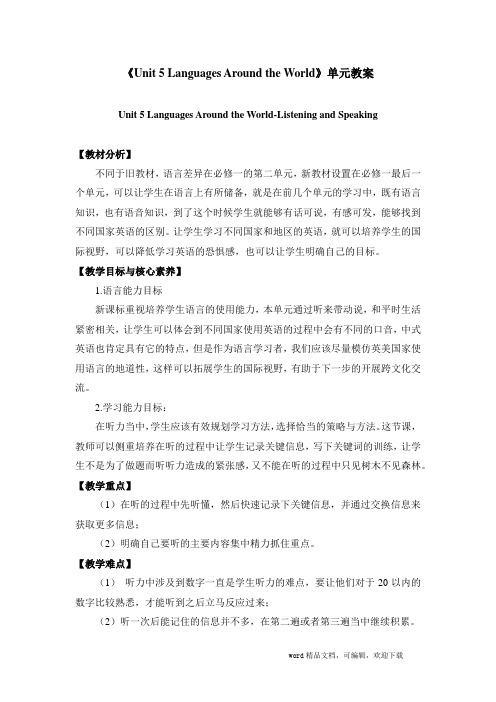
《Unit 5 Languages Around the World》单元教案Unit 5 Languages Around the World-Listening and Speaking【教材分析】不同于旧教材,语言差异在必修一的第二单元,新教材设置在必修一最后一个单元,可以让学生在语言上有所储备,就是在前几个单元的学习中,既有语言知识,也有语音知识,到了这个时候学生就能够有话可说,有感可发,能够找到不同国家英语的区别。
让学生学习不同国家和地区的英语,就可以培养学生的国际视野,可以降低学习英语的恐惧感,也可以让学生明确自己的目标。
【教学目标与核心素养】1.语言能力目标新课标重视培养学生语言的使用能力,本单元通过听来带动说,和平时生活紧密相关,让学生可以体会到不同国家使用英语的过程中会有不同的口音,中式英语也肯定具有它的特点,但是作为语言学习者,我们应该尽量模仿英美国家使用语言的地道性,这样可以拓展学生的国际视野,有助于下一步的开展跨文化交流。
2.学习能力目标:在听力当中,学生应该有效规划学习方法,选择恰当的策略与方法。
这节课,教师可以侧重培养在听的过程中让学生记录关键信息,写下关键词的训练,让学生不是为了做题而听听力造成的紧张感,又不能在听的过程中只见树木不见森林。
【教学重点】(1)在听的过程中先听懂,然后快速记录下关键信息,并通过交换信息来获取更多信息;(2)明确自己要听的主要内容集中精力抓住重点。
【教学难点】(1)听力中涉及到数字一直是学生听力的难点,要让他们对于20以内的数字比较熟悉,才能听到之后立马反应过来;(2)听一次后能记住的信息并不多,在第二遍或者第三遍当中继续积累。
【教学过程】Unit 5 Languages Around the World-Reading and Thinking【教材分析】本节课是高中英语第一册的最后一个单元的阅读和思考部分,文章难度明显增加,体现在以下几个方面:文章题材是说明文,比较难理解;话题生疏,涉及到历史等知识;生词量增大,而且在语境中理解词汇的要求提高。
高一英语必修一第五单元教案精选5篇

高一英语必修一第五单元教案精选5篇高一英语必修一第五单元教案【篇1】第一部分:热身快速应答:1.How are you going to school everyday?2.Thank you very much for your help.3.Would mind my opening the window?4.What day was it yesterday?5.What's the weather like today?第二部分:朗读口语朗读技巧:1.声调与降调I have three English books, two Chinese dictionaries and five pens. Do you havea map in your hand? Yes, I do.2.连读:将前一个单词最后的辅音与后一个单词开头的元音连在一起朗读。
half an hour ran out of not at all3.失爆:当相邻两个爆破音在一起时,往往给前面一个爆破音留一个位置,但不爆破,稍停随即发后面的爆破音,这种现象称为“失爆”。
hot bath the next day a good deal of I don’t believe I don’t know I want to say朗读练习:1. A smart housewife was told that there was a kind of stove which would only consume half of the coal she was burning. She was very excited, and said: That'll be terrific! Since one stove can save half of the coal, if I buy two, no coal will be needed!2.The little boy did not like the look of the barking dog.It's all right, said a gentleman, don't be afraid. Don't you know the proverb: Barking dogs don't bite?Ah, yes, answered the little boy. I know the proverb, but does the dog knowthe proverb, too?高一英语必修一第五单元教案【篇2】一、教材分析:本课是结合人教版高中英语教材选修5中有关过去分词的语法内容,进行过去分词的学习,教学中将语法知识的传授和语言基本技能的学习结合到一起,注重复习语法与语言的运用。
【教案】Unit+5Reading+for+writing+教学设计人教版高中英语必修第一册
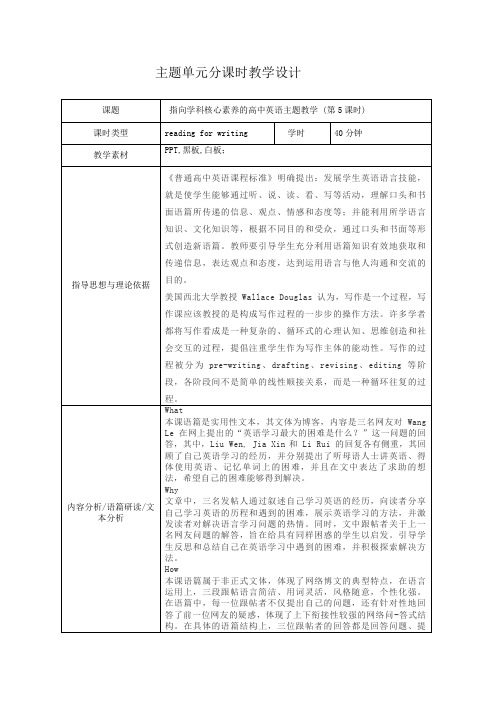
主题单元分课时教学设计课题 指向学科核心素养的高中英语主题教学 (第5课时)课时类型reading for writing学时40分钟教学素材PPT,黑板,白板;指导思想与理论依据《普通高中英语课程标准》明确提出:发展学生英语语言技能,就是使学生能够通过听、说、读、看、写等活动,理解口头和书面语篇所传递的信息、观点、情感和态度等;并能利用所学语言知识、文化知识等,根据不同目的和受众,通过口头和书面等形式创造新语篇。
教师要引导学生充分利用语篇知识有效地获取和传递信息,表达观点和态度,达到运用语言与他人沟通和交流的目的。
美国西北大学教授Wallace Douglas认为,写作是一个过程,写作课应该教授的是构成写作过程的一步步的操作方法。
许多学者都将写作看成是一种复杂的、循环式的心理认知、思维创造和社会交互的过程,提倡注重学生作为写作主体的能动性。
写作的过程被分为pre-writing、drafting、revising、editing等阶段,各阶段间不是简单的线性顺接关系,而是一种循环往复的过程。
内容分析/语篇研读/文本分析What本课语篇是实用性文本,其文体为博客,内容是三名网友对Wang Le在网上提出的“英语学习最大的困难是什么?”这一问题的回答,其中,Liu Wen, Jia Xin和 Li Rui 的回复各有侧重,其回顾了自己英语学习的经历,并分别提出了听母语人士讲英语、得体使用英语、记忆单词上的困难,并且在文中表达了求助的想法,希望自己的困难能够得到解决。
Why文章中,三名发帖人通过叙述自己学习英语的经历,向读者分享自己学习英语的历程和遇到的困难,展示英语学习的方法,并激发读者对解决语言学习问题的热情。
同时,文中跟帖者关于上一名网友问题的解答,旨在给具有同样困惑的学生以启发。
引导学生反思和总结自己在英语学习中遇到的困难,并积极探索解决方法。
How本课语篇属于非正式文体,体现了网络博文的典型特点,在语言运用上,三段跟帖语言简洁、用词灵活,风格随意,个性化强。
高一英语必修一unit5教案

高一英语必修一unit5教案教案名称:Unit 5: Meeting Your New Classmates教学目标:1. 通过学习本单元,学生将能够运用描述人物特征和外貌的词汇,并能够进行简单的自我介绍。
2. 学生将能够在日常生活中运用所学的词汇和句型进行交流,并能够发展有效的交际能力。
3. 学生将培养对他人的关心和尊重,增强团队合作意识。
教学重点:1. 掌握描述人物特征和外貌的词汇。
2. 学会运用目标语言进行简单的自我介绍。
3. 发展有效的交际能力。
教学难点:1. 学生能够使用目标语言进行简单的自我介绍。
2. 学生能够在日常生活中运用所学的词汇和句型进行交流。
教学准备:教材:高中英语必修一(人教版)第五单元的教科书、课后习题、配套教学光盘等。
辅助教具:录音机、多媒体设备、图片、班级展示板等。
教学过程:Step 1: Warm-up (5 minutes)1. Greetings: Greet the students and ask them how they are doing.2. Show pictures of people with different appearances (such as tall, short, fat, thin, etc.) and ask students to describe their appearances.3. Ask students to introduce themselves to their classmates briefly.Step 2: Presentation and Practice (25 minutes)1. Introduce new vocabulary related to physical appearance and personality traits, such as tall, short, fat, thin, funny, serious, etc. Use pictures and gestures to help students understand and remember the words.2. Play the audio files to help students practice pronouncing the new words.3. Ask students to work in pairs and describe their partners using the new vocabulary. For example, \。
人教版高中英语必修一 unit5教案

教案纸如:You needn’t have bought such an expensive watch for her.你本不必给她买这么贵的手表。
need作为情态动词一般用于疑问句和否定句中。
【活学活用】(1)—You before you opened the door.—I beg your pardon. I didn't know that anyone was in here.“你推门进来之前本该先敲门的。
”“对不起,我不知道这里面有人。
”(2)I the meeting on time—unless I had caught an earlier train.我不可能准时赶到会场——除非我赶上了较早的一班火车。
(3)If he had taken the doctor's advice, he ____________________ (recover) from his illness already. 如果他听从了医生的建议的话,他的病可能已经好了。
(4)They ________have stayed up late last night—all of them look sleepy.他们昨天晚上肯定熬得很晚了,他们看起来全都非常困倦。
(5)We ____________________ so much food now that Suzie won't be with us for dinner.既然苏西不和我们一起吃晚饭,我们本没必要买如此多的食物。
should have knocked couldn't have got to might have recovered must needn't have bought7. We read books under our blankets and used anything we could find to make candles to see the words.我们躲在毯子下面读书,用可以找到的任何东西做蜡烛来看书。
- 1、下载文档前请自行甄别文档内容的完整性,平台不提供额外的编辑、内容补充、找答案等附加服务。
- 2、"仅部分预览"的文档,不可在线预览部分如存在完整性等问题,可反馈申请退款(可完整预览的文档不适用该条件!)。
- 3、如文档侵犯您的权益,请联系客服反馈,我们会尽快为您处理(人工客服工作时间:9:00-18:30)。
Unit 5 Nelson Mandela——a modern hero教材分析:本单元以Nelson Mandela —— a modern hero为话题,目的在于使学生了解一个伟大的人应具备怎样的品质,学会表达自己的观点,并用所学的句型来描写一个伟人。
提示:1、本单元从warm-up开始,到最后的writing,都是以第三人称的角度来进行描述的,因此,教学中要注意这种人称的前后一致,否则无法前后一致的引导学生进行学习和表达。
2、Reading部分侧重于理解,以及理解基础上的summary,这为最后的writing做好的铺垫和积累(尤其是关键单词、句型和结构的积累),最后的writing要是前面阅读后的仿写(当然能力较强的学生也可以不受限制的开展写作)。
3、如何激发学生学习关于这些伟人的文章,是需要教师思考的:这些伟人学生会感兴趣吗?学生了解多少关于这几位伟人的伟大业绩?从哪些角度来导入会让学生更加的感兴趣?4、教学目标建议增加:通过学习文章和相关素材,进一步了解伟人的生平事迹,尤其是如何才能成为伟人。
培养学生初步使用相关词汇、句型和文章结构进行人物生平描述的口语表达和基础写作能力。
Teaching aims:1. To arouse Ss’ interest in learning about heroes in history2. To develop Ss’ listening and speaking ability.Teaching procedures:Step1 warming up●Describe yourselvesFirst what kind of person are you? (shy, outgoing, fun, mean, immature, nice, kind, honest, brave, loyal, happy, wise, smart, friendly, warm, cheerful, popular, generous, hard-working, diligent, weak, stupid, lazy, dishonest, tense, cold, unkind, miserable, dull, strong-minded, determined etc.)●Discussion (Encourage students to give five or six qualities that they think greatpersons have, and give their reasons.)提示:What kind of great persons? Politicians,scientists, or? Different kinds of great persons, different qualities.Question 1: Who do you think are the greatest men in your mind? Can you name some?Question 2: In what way do you consider a man is a great? What is your standard?●Look at page 33 and then ask the Ss if these famous people are great people.●Conclusion:A great person is a person who has followed his or her ideas and sacrificed(牺牲) something so that they could be realized. A pop singer may be very popular with the young people, but he/she is not a great man/woman.A famous person may be well-known but if he or she has not gone through struggles and difficulties for their noble aims, they can not be called a great person.Step2 language points:1.devote vtoneself to 献身于、致力于。
devote one’s life/one’s time to….把生命、时间献给。
…to …把。
用于。
E.g. He devoted his life to promoting world peace.He devoted his life to the promotion of world peace.devoted adj 忠实的, 深爱的be devoted to 对…忠实, 对…深爱a devoted friendShe is devoted to her husband.即学即练The manager devotes all his spare time ______ the violin. BA. to practiseB. to practisingC. in practisingD. for practising2. fight for 为……而战fight against 与……作斗争;与…作战fight with 同…并肩作战; 与… 作战E.g. We will have to fight against difficulties.I’ll fight with you, in other words, I’ll support you.Slaves were fighting for freedom.3. give up 表示主动放弃或屈服e.g. He has decided to give up smoking.give in 表示被动屈服或认输,后面不带宾语。
如果接宾语用give in toe.g. You can’t win the game, so you may as well give in.The second period-----extensive readingTeaching aims:1) To have Ss learn about some information about Nelson Mandela and the situation where the black was badly or unfairly treated.2) To get Ss to learn about reason why Nelson Mandela helped the black people to get the same right as white people.Teaching procedures:Step1 make prediction:Read the title of the text and guess what kind of writing the text is. (Narrative writing) Step2 scanning: read the text quickly and then decide how many parts this text can be divided into and then give the main ideas of each part.Part 1(Para. 1---2) The life of Elias’ before he met Nelson MandelaPart 2(Para.3---5) The change of Alias life after he met Nelson Mandela and what Mandela did.Step 3 skimming:Scan the test specific information to finish comprehending part.Step 4Let’s go over the text once more to make a diagram of it with key words of eachHomework1. Go over the “Reading” and find out the useful expressions in it.The third period----intensive readingLanguage points:1. The time when I first met Nelson Mandela was a very difficult period of my life.when在句子中引导的是时间定语从句。
when指时间,在定语从句中做时间状语:e.g. I still remember the day when I first came to the school.The time when we got together finally came.2. It was in 1952 and Mandela was the black lawyer to whom I went for advice. advice n. a piece of advice 一条建议ask for advice征求意见give sb. advice on…关于…给某人建议advise v.1) advise sb. on/ about sth. 就……给某人出主意e.g. I have advised you on that subject.2) advise sb. to do sth. 建议某人干……e.g. Our monitor advises me to practice more spoken English.3)advise doing sth建议做某事e.g. I advise waiting until tomorrow.4) advise that + (should) doe.g. I advise that you (should) not eat fruit that isn’t ripe.即学即练I ____ my father to give up smoking, but he didn’t think it was necessary. A A. advised B. hoped C. persuaded D. suggested提示:这种“即学即练”对于学生来说能锻炼什么呢?我觉得还是练习阅读理解的,不是练习词义选择的。
